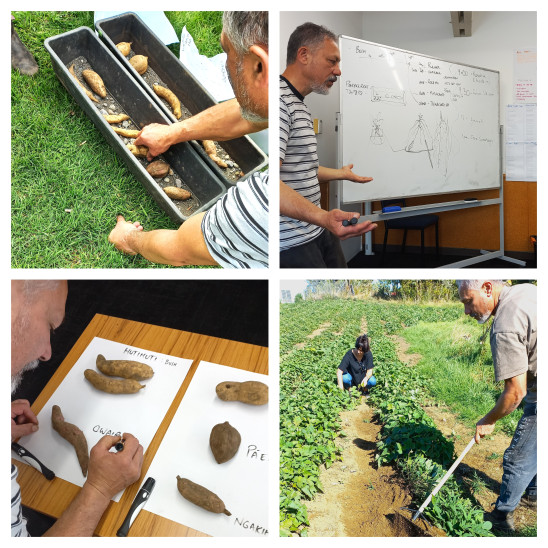WITT students learn kumara cultivation and kaitiakitanga
WITT horticulture students are preparing to harvest their first kūmara crop grown in the campus organic vegetable gardens. The yield is the result of time spent on a local marae where they learned traditional methods for producing the indigenous root vegetable.
Ākonga studying for the New Zealand Certificate in Organic Primary Production (Level 4) visited Kātere Marae, Waiwhakaiho, of Ngāti Tāwhirikura hapū last spring and again this year. They were guided by renowned Māori horticulturalist Glen Skipper, who has been growing kūmara crops in the marae’s Te Moeone mārakai (food garden) for 15 seasons.
Glen shared his knowledge on how to grow tipu (seedlings), cultivate and prepare kūmara beds, and harvest and store kūmara. He demonstrated the use of traditional tools, such as the ketu - a small paddle-like tool, used for loosening the soil around kūmara plants - and kāheru – a spade for creating mounds and cultivating kūmara.
Glen, who is on the local advisory committee for horticulture at WITT, also supports kūmara gardens at Ahu Ahu Rd, south of Oakura, where kūmara are grown for Parihaka.
He grows 11 varieties of kūmara, many different to the commercial varieties sold in supermarkets and including three old varieties that Māori grew locally pre-colonisation.

Many people are surprised to learn that kūmara can be grown successfully in Taranaki, says Glen. Most commercial kūmara is grown in Northland where warmer, drier conditions prevail. In a cooler, wetter climate such as Taranaki, the biggest challenge is how to store the crop. Kūmara must be carefully dried and cured post-harvest. Glen has been experimenting with varieties to breed the most resilient crops suited to local conditions, including kūmara with combinations of cream, gold, orange, purple and pink skin and flesh.
Course tutor Carl Freeman says the experience has been eye-opening for the students as they’ve discovered the diversity of varieties of kūmara, and a wealth of knowledge based on tikanga (traditional methods) on how to successfully grow the much-loved vegetable in local conditions.
Harvesting their first crop in May will be a special event. “The students have learned not only how to grow, harvest and store kūmara – they understand their role as kaitiaki [guardians] of these important crops for future generations,” says Carl.
During the one-year programme they encounter topics such as soil health and soil management, and how to produce vegetables, fruit and herbs through all seasons.
Scholarships available for next intake in Semester Two
The next intake for the programme is Semester Two, starting August 17.
Five scholarships, valued at $3000 each, are available for people interested in doing the New Zealand Certificate in Organic Primary Production (Level 4). The financial support for organics training is a welcome boost on the path to transforming Taranaki into a future food bowl, Carl says.
The scholarships came about through a partnership with the Bashford Nichols Trust and the Bishop’s Action Foundation.
The deadline to apply for a scholarship is May 31. For more info, contact: C.Freeman@witt.ac.nz
Find out more about primary production, horticulture, and organic growing courses at WITT here.
Caption: Glen Skipper (second from left) with WITT students working on kumara crops at a local marae, and (below) Glen with some of the many kumara varieties he has been experimenting with for local soil and climate conditions.